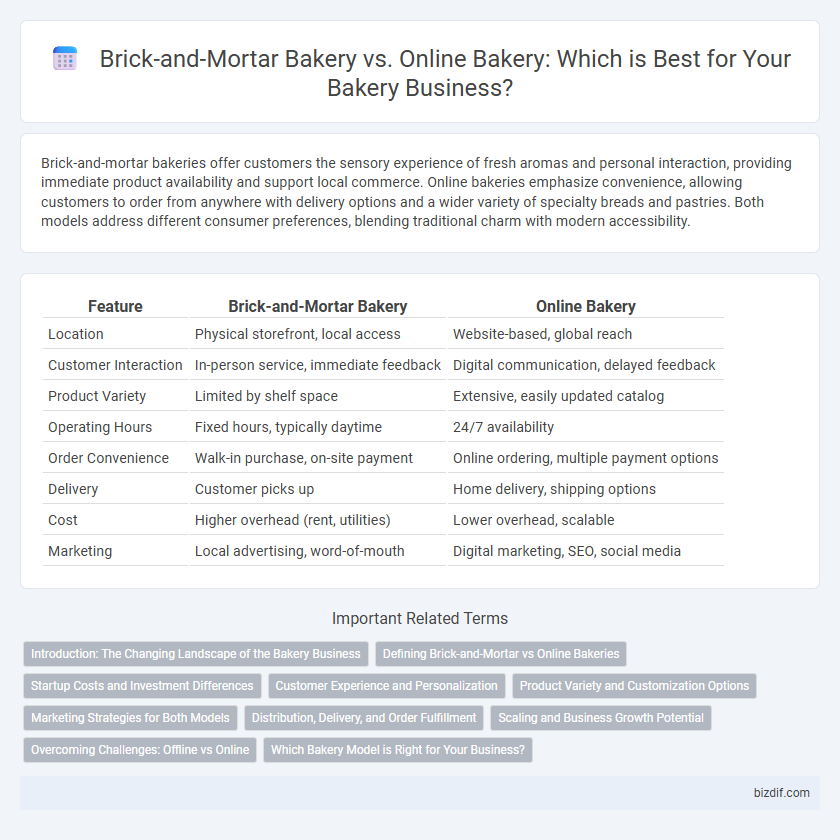Brick-and-mortar bakeries offer customers the sensory experience of fresh aromas and personal interaction, providing immediate product availability and support local commerce. Online bakeries emphasize convenience, allowing customers to order from anywhere with delivery options and a wider variety of specialty breads and pastries. Both models address different consumer preferences, blending traditional charm with modern accessibility.
Table of Comparison
| Feature | Brick-and-Mortar Bakery | Online Bakery |
|---|---|---|
| Location | Physical storefront, local access | Website-based, global reach |
| Customer Interaction | In-person service, immediate feedback | Digital communication, delayed feedback |
| Product Variety | Limited by shelf space | Extensive, easily updated catalog |
| Operating Hours | Fixed hours, typically daytime | 24/7 availability |
| Order Convenience | Walk-in purchase, on-site payment | Online ordering, multiple payment options |
| Delivery | Customer picks up | Home delivery, shipping options |
| Cost | Higher overhead (rent, utilities) | Lower overhead, scalable |
| Marketing | Local advertising, word-of-mouth | Digital marketing, SEO, social media |
Introduction: The Changing Landscape of the Bakery Business
Brick-and-mortar bakeries continue to attract customers through sensory experiences like fresh aromas and in-store sampling, creating a loyal local clientele. Online bakeries capitalize on expanding market reach and convenience by offering diverse products with home delivery options, leveraging digital marketing and e-commerce platforms. The bakery business landscape is shifting toward hybrid models that integrate physical storefronts with robust online operations to meet evolving consumer preferences.
Defining Brick-and-Mortar vs Online Bakeries
A brick-and-mortar bakery operates from a physical storefront where customers can browse and purchase fresh baked goods in person, emphasizing local presence and immediate product access. Online bakeries function through digital platforms, offering the convenience of browsing and ordering baked products remotely, often with shipping or delivery services. The distinction lies in customer interaction methods and service accessibility, impacting marketing strategies and customer engagement approaches.
Startup Costs and Investment Differences
Brick-and-mortar bakeries require substantial startup costs, including rent, utilities, equipment, and staff wages, often exceeding $100,000 depending on location size and market. Online bakeries have lower initial investments, mainly focused on kitchen equipment, packaging, website development, and digital marketing, which can start under $30,000. The ongoing operational expenses in physical stores are higher due to overhead and in-person service requirements, whereas online bakeries benefit from flexible scaling and reduced fixed costs.
Customer Experience and Personalization
Brick-and-mortar bakeries offer a tactile and sensory experience, allowing customers to see, smell, and sample fresh baked goods while receiving personalized recommendations from staff. Online bakeries provide convenience and customization through digital ordering systems, enabling customers to tailor products to their preferences with detailed descriptions and customer reviews enhancing decision-making. Both models utilize personalization, but brick-and-mortar bakeries excel in face-to-face interactions, whereas online bakeries leverage technology for tailored user experiences.
Product Variety and Customization Options
Brick-and-mortar bakeries offer a tactile experience with a curated selection of fresh pastries and breads, allowing customers to see and smell products before purchase, but may have limited daily variety due to physical space constraints. Online bakeries provide a broader product assortment, including specialty and seasonal items, with extensive customization options such as personalized cakes and dietary-specific treats, facilitated by digital ordering platforms. This digital model also enables bakeries to cater to niche markets and deliver nationwide, expanding customer reach beyond local foot traffic.
Marketing Strategies for Both Models
Brick-and-mortar bakeries leverage local SEO, community events, and in-store promotions to drive foot traffic and build brand loyalty through personalized customer experiences. Online bakeries focus on social media marketing, targeted ads, and seamless e-commerce platforms to reach broader audiences and facilitate convenient ordering. Both models benefit from integrating user-generated content and email marketing to maintain engagement and foster repeat sales.
Distribution, Delivery, and Order Fulfillment
Brick-and-mortar bakeries rely on direct customer interactions for distribution, offering immediate product gratification and personalized service. Online bakeries utilize digital platforms to streamline order fulfillment, often partnering with third-party delivery services to extend their reach beyond local neighborhoods. Efficient logistics and inventory management systems are critical for online bakeries to maintain product freshness and timely delivery while accommodating fluctuating order volumes.
Scaling and Business Growth Potential
Brick-and-mortar bakeries benefit from a strong local presence and immediate customer interaction, limiting scaling potential to geographic reach and physical space constraints. Online bakeries leverage digital platforms to reach a broader market, enabling rapid scaling through expanded delivery zones and lower overhead costs. Integrating e-commerce with traditional storefronts maximizes growth by combining personal service with scalable online sales.
Overcoming Challenges: Offline vs Online
Brick-and-mortar bakeries face challenges such as high rental costs, limited customer reach, and dependence on foot traffic, requiring strategic local marketing and exceptional in-store experiences to thrive. Online bakeries overcome geographic limitations and operate with lower overhead but must invest heavily in website optimization, reliable delivery systems, and digital marketing to build trust and manage customer expectations. Both models benefit from integrating customer feedback loops and leveraging data analytics to enhance product offerings and service quality.
Which Bakery Model is Right for Your Business?
Choosing between a brick-and-mortar bakery and an online bakery depends on factors like customer accessibility, startup costs, and operational scalability. Brick-and-mortar bakeries provide direct customer interaction and local brand presence, while online bakeries offer broader market reach and lower overhead expenses. Analyzing target demographics, location, and digital marketing capabilities helps determine the most effective bakery model for your business goals.
Brick-and-Mortar Bakery vs Online Bakery Infographic

 bizdif.com
bizdif.com